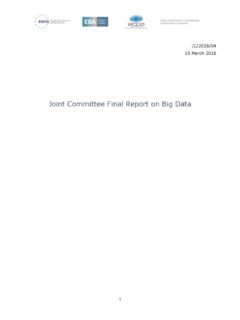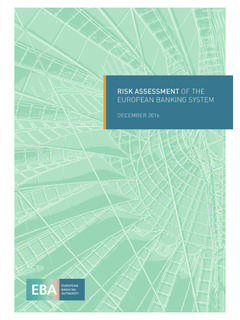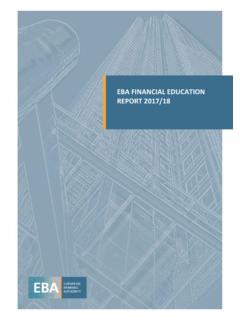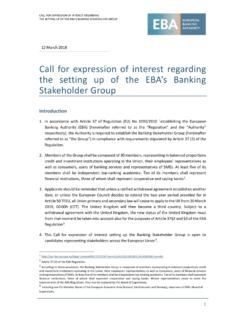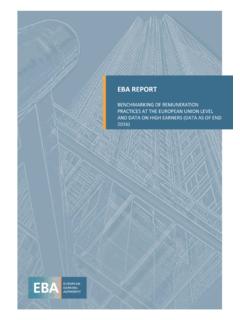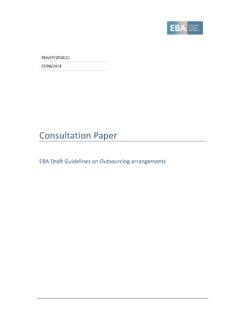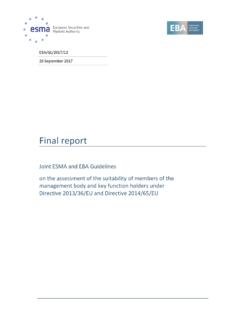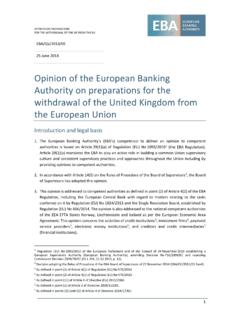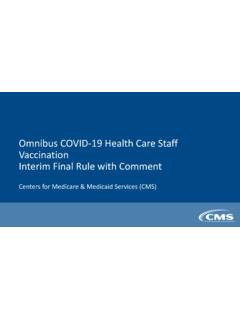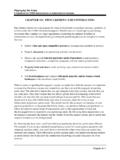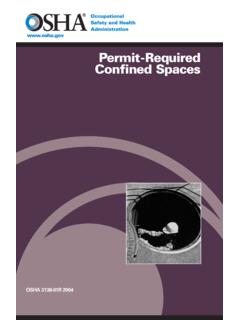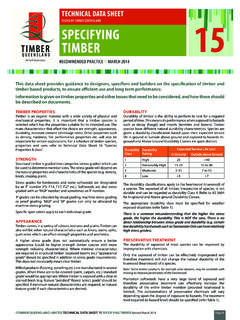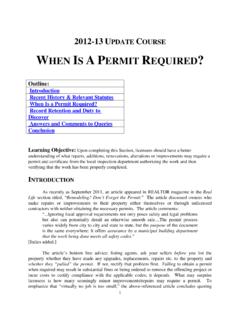Transcription of Final report
1 EBA/RTS/2021/15 13 December 2021 Final report on draft regulatory technical standards with regard to specifying the calculation of specific credit risk adjustments Amending Delegated Regulation (EU) No 183/2014 supplementing Regulation (EU) No 575/2013 of the European Parliament and of the Council on prudential requirements for credit institutions and investment firms with regard to regulatory technical standards for specifying the calculation of specific and general credit risk adjustments Final report - REVISED RTS ON CREDIT RISK ADJUSTMENTS 2 Contents 1. Executive summary 3 2.
2 Background and rationale 4 3. Draft regulatory technical standards 8 4. Accompanying documents 12 Draft cost-benefit analysis/impact assessment 12 Feedback on the public consultation 14 Final report - REVISED RTS ON CREDIT RISK ADJUSTMENTS 3 1. Executive summary On 16 December 2020, the European Commission published its action plan on Tackling non-performing loans in the aftermath of the COVID-19 pandemic1, in which it indicated the need for a revision of the treatment of defaulted exposures under the standardised approach for credit risk (SA). Section of the Commission action plan asks the European Banking Authority to consider the appropriate prudential treatment of the risk weight (RW) for defaulted exposures following the sale of a non-performing asset ( NPL assets ).
3 In particular, it is noted that a 100% RW compared to the normal RW of 150% can be applied when provisions cover more than 20% of an exposure; however only provisions/write-downs (so-called credit risk adjustments ) made by the institution itself can be accounted for, not write-downs accounted for in the transaction price of the exposure . The proposed amendments allow for the recognition of such write-downs accounted for in the transaction price of the exposure, which are retained by the seller, in the credit risk adjustments recognised for the determination of the RW of defaulted exposures applied by the buyer under the SA.
4 This is achieved by introducing an amount (that could be seen as a discount ) that would have to be added to the amount of specific credit risk adjustments used to determine the appropriate RW under Article 127(1) of Regulation (EU) No 575/2013. As a consequence, the amount used to determine the RW under Article 127(1) of Regulation (EU) No 575/2013 is designed in such a way that the purchase of an asset with a discount equal to the amount of specific credit risk adjustments that were assigned to the exposure by the seller does not change its RW. The EBA has taken the step of implementing this change via an RTS amendment, as this will ensure that regulatory treatment of sold NPL assets will be clarified.
5 However, it is also recommended that the treatment set out in these RTS is included directly in the level 1 text, which is the case in the amending CRR Commission proposal published on 27 October 2021. Next steps The Final draft RTS will be submitted to the Commission for endorsement before being published in the Official Journal of the European Union. The technical standards will apply 20 days after their publication in the Official Journal of the European Union. 1 See The EBA press release relating to this plan can be found here: EBA welcomes European Commission s action plan to tackle NPLs in the aftermath of the COVID-19 pandemic | European Banking Authority ( ).
6 Final report ON AMENDED RTS ON CREDIT RISK ADJUSTMENTS 4 2. Background and rationale On 16 December 2020, the European Commission published its Action Plan on Tackling non-performing loans in the aftermath of the COVID-19 pandemic, where it indicated the need for a revision of the treatment of defaulted exposures under the SA. This request is part of the comprehensive action plan by the Commission to tackle the expected rise in non-performing loans (NPLs) on banks balance sheets following the outbreak of the COVID-19 pandemic. The EBA has been given a number of tasks, and one of the requests is for the EBA to address regulatory impediments to NPL purchases.
7 Section of the Commission Action Plan asks the European Banking Authority to consider the appropriate prudential treatment of the risk weights ( RW ) for defaulted exposures following the sale of a non-performing asset. In particular, it is noted that a 100% RW compared to the normal RW of 150% can be applied when provisions cover more than 20% of an exposure; however only provisions/write-downs (so-called credit risk adjustments ) made by the institution itself can be accounted for, not write-downs accounted for in the transaction price of the exposure . The proposed amendments allow for the inclusion of, in particular, any write-downs accounted for in the transaction price of the exposure which are retained by the seller as a realised loss, in the credit risk adjustments recognised for the determination of the RW of defaulted exposures applied by the buyer under the SA at the sale date.
8 This is achieved via the introduction of an amount (which could be seen as a discount ) that would have to be added to the amount of specific credit risk adjustments used to determine the appropriate RW under Article 127(1) of Regulation (EU) No 575/2013. As a consequence, the amount used to determine the RW under Article 127(1) of Regulation (EU) No 575/2013 is designed in such a way that the purchase of an asset with a discount equal to the amount of specific credit risk adjustments that were assigned to the exposure by the seller does not change its RW. However, the discount is defined in a dynamic way in order to take into account any future revaluations of the exposure.
9 Lowering the SA risk weight where at least 20% of a defaulted exposure is covered by specific credit adjustments acknowledges a shift from unexpected losses (UL) to expected losses (EL), which is the same reason for the decrease in IRB risk weights above certain PD levels. Unlike in the IRB approach, there is no prudential measure of EL under the SA for credit risk; instead, specific credit risk adjustments under the applicable accounting framework serve as a proxy for the prudential EL level. Relying on this EL proxy does not work, however, for the buyer of NPLs. Via a purchase price discount, not only previous specific credit risk adjustments made by the seller, but also any loss of bargain power effects are retained by the seller as realised losses.
10 This loss retention by the seller justifies taking the purchase price discount into account for identifying the EL level of a purchased NPL. On the other hand, it is also necessary to continue identifying any decrease in EL after the purchase, as this could shift more credit risk back to UL, which could necessitate an increase in the SA risk weight after the purchase, partly because, all other things being equal, the same increase in the SA risk weight would also have occurred for the seller. Final report ON AMENDED RTS ON CREDIT RISK ADJUSTMENTS 5 A decrease in EL may happen when the buyer recognises some of the purchase price discount as increasing CET1 capital and no CET1 capital reductions exist for an exposure.

